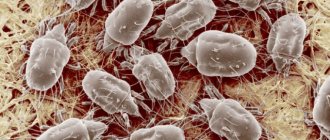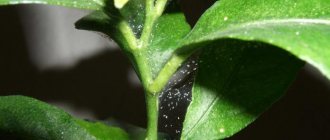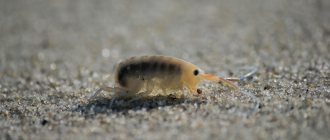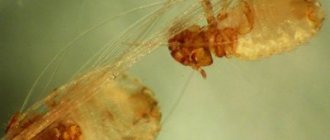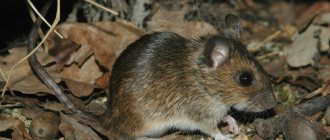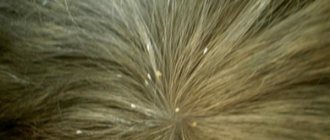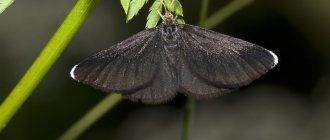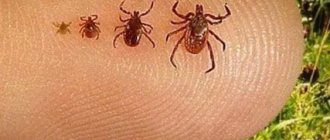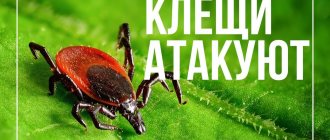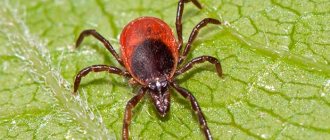Ticks in September and other autumn months. The phases of greatest activity of parasites, when they are most aggressive and dangerous. What dangerous diseases are carried? What symptoms should you pay attention to? How to remove an attached tick yourself. Possible methods of protection against ticks.
Many people believe that ticks are most dangerous in the spring, with the arrival of warmer weather, and during the rest of the period they do not pose a great danger. This opinion is erroneous because these parasites have two active seasons, the first is spring, the second is autumn.
If we talk about the threat they pose to humans and animals, ticks in September are just as dangerous as at any other time, since they are carriers of infection regardless of the season. Next, we will take a closer look at the active seasons, find out whether they are aggressive in the fall, what danger they pose and how to protect yourself from them.
Seasons of activity
If we talk about the seasonality of these parasites, it will be easier to determine the period when they are not active. After all, they are very tenacious and easily tolerate any climatic conditions if the air temperature rises above 6-8°C. The only climatic conditions under which they cannot lead an active lifestyle are frosts.
With the onset of frost, they go into a period of hibernation, fall asleep and disappear, and with the arrival of the first warmth they go through the following phases of activity:
- April May. The first phase of activity falls during this period. No one can say exactly when the seasonality of parasites will begin, since this is directly related to climatic conditions and temperature conditions. They wake up from winter sleep at an air temperature of 6-8°C. It is during this period that they are considered the most aggressive, since they are hungry and require nutrition for development and reproduction.
- June August. From the second half or end of June until August, a decrease in activity is observed. This is due to a period of temporary physiological rest, but at this time they can also attack people and animals, just in much smaller numbers.
- September October. The second phase of activity, when ticks become as aggressive as during the first phase. This is due to the fact that they require complete saturation in order to easily endure hibernation.
Where do they live in winter?
Basically, ticks live in forests and parks in winter, but not always. As soon as the air temperature becomes low, they begin to look for the nearest suitable shelter to sleep. If an animal brings a tick into the house in late autumn, it will overwinter there. There are several other sources where ticks can appear in your home in winter. If you run a subsistence farm and stock up on hay or straw for animals for the winter, ticks also live very comfortably in winter in such deposits. Sometimes ticks overwinter in the bark of trees, which is why you can bring a tick into your house on the Christmas tree or along with firewood. True, these parasites rarely overwinter in coniferous forests, because the lack of leaf cover reduces their chances of survival in a snowless winter.
Appearance
These parasites belong to the group of arthropods, of which there are about 40 thousand species. Among them are ixodid parasites, whose diet consists of human and animal blood. Depending on the species, ticks can have different body sizes from 3 to 25 mm. The shape of the body is elongated and flattened, consists of a torso and head, and has fragments of elastic and hard tissue.
They have a piercing-sucking mouthparts, which they use to puncture the skin and stick to a blood vessel with their proboscis. The length of the proboscis may differ among individuals of different species.
They do not have organs of vision, but the absence of eyes does not at all prevent them from perfectly orienting themselves in space and easily finding food sources. The fact is that they have well-developed sensitive receptors, which replace the function of vision.
The body is covered with a kind of shield that protects the body from damage. In females it is small in size and covers only part of the body, while in males it covers completely.
They have 4 pairs of legs, each with a suction cup and claws, which allow the tick to hold firmly on any surface. Females always have larger body sizes than males, they also differ in color, the female has a brown tint, and the male is brown.
When saturated with blood, the parasites increase significantly in size; one individual can suck twice as much blood as it weighs. During saturation, the shape of the body changes, they become oval, and the color also changes to red.
More about the parasite
One of the human companions, the linen or bed mite, lives for several hundred years and is distributed in all parts of the world. He feels comfortable with a person. It feeds on dead skin cells, dandruff, lost hair, hides in the folds of dirty bed linen, in pillows, blankets, mattresses and feels great in a dusty room that has not been cleaned for a long time.
Note! A person does not notice the presence of a bed mite if he has good immunity and does not know what an allergic reaction is. Sensitive people have it more difficult
Their skin and respiratory organs respond to pest bites with endless runny nose, coughing, sneezing, and skin irritations in the form of a small red rash
Sensitive people have it more difficult. Their skin and respiratory organs respond to pest bites with endless runny nose, coughing, sneezing, and skin irritations in the form of a small red rash.
It is possible to examine a bed mite (it is a type of saprophyte) only with the help of a microscope, it is so small.
A tick (as we see it in photographs) looks like this:
- yellow-brown;
- the body is flattened, covered with chitin;
- length – from 0.2 to 0.6 mm;
- six limbs with suction cups;
- head in the shape of a triangle.
An adult tick lives for a month and a half, during which time the female lays more than three hundred eggs.
What danger do they pose to humans?
Regardless of when exactly the tick attacks, in September or May, there is always the possibility of infection with dangerous diseases. These individuals are carriers of diseases such as encephalitis, borreliosis, fever, typhus and others. Of course, not all individuals are infected and carry the virus, but absolutely all can cause a number of other problems.
An insect bite can cause inflammation, irritation, and allergic reactions. There is always a risk of germs and bacteria getting into the wound, which will cause the wound to fester.
Also, if a blood-sucking substance is found on the body, you need to go to the hospital so that the doctor can remove it correctly. When removing an attached parasite yourself, there is always a risk of making mistakes. Fragments of insects may remain in the wound, infection may occur, etc.
What places to avoid
Unfortunately, there are simply no places where complete safety from these parasites is guaranteed. Regardless of whether you are going on vacation to the Moscow region or another region, during periods of activity they can be found in absolutely any territory.
There are some weather conditions that are not entirely suitable for them, such as dry and hot weather. Then they prefer to hide in shaded places where humidity is maintained. Large populations are found in deciduous and mixed forests; there are more favorable conditions for development and reproduction.
Regarding places that are best avoided in September and other warm periods, these include tall grass, shaded areas, willow trees, lake and river banks, and ditches. Of course, they can also be found in urban environments, especially parks. There is an opinion that parasites attack people by jumping from trees; these assumptions are misleading.
The fact is that these insects cannot tolerate direct sunlight, the ideal temperature is up to 21°C and necessarily high humidity. There are no favorable conditions for them at the tops of trees. In addition, these small parasites move very slowly and cannot cover long distances, and climbing to the top of a tree is not an easy task.
They are quite intelligent and hide in the grass and bushes near animal trails, where prey often passes and is easy to attack. In urban environments, they attack dogs and cats from the grass, and if a person passes, they cling to the legs and crawl upward to find a place to bite.
Bite protection
When going on vacation to a forest area, you need to find out whether ticks have appeared. Sometimes there is a period of calm, the insects hide, and protective equipment is not required. Basic rules to help protect yourself from insect attacks when they are active:
- You need to wear a hat and scarf.
- Clothing must be tight and cover all parts of the body. It is easier to notice the insect against a light background, so wear plain, light-colored clothes.
- The tick will not get under your clothes if you tuck your shirt into your trousers and the bottom of your trousers into socks or high boots.
- Choose shoes that fit tightly.
- It is necessary to treat exposed skin with repellents, and acaricides on clothing.
- When picking berries and mushrooms, you should not linger for a long time under one bush or tree.
- You can't lie down on the grass to rest
- Clothing is inspected for the presence of parasites every 1.5 hours.
- Before the hike, the dog is treated with repellents, then a tick collar is put on it.
- Insects cannot stand the smell of lemon and lavender. When going outdoors, all parts of the body not covered by clothing should be rubbed with lavender or lemon oil. But you should know that these products do not guarantee 100% protection.
Upon returning home, outer and underwear are checked for insects. The body is carefully examined. Comb the hair with a fine-toothed comb. In regions where the insect population is increased, it is recommended to vaccinate against encephalitis. Since it is carried out in 3 stages, preparations begin in winter. This will allow the body to develop immunity to the onset of mite activity.
Chemical repellents
There is a large selection of protective agents on sale that act in different ways. They are divided into 3 groups:
- killing agents - “Tornado-anti-mite”, “Reftamid taiga”;
- repellents - “Dipterol”, “Pretix”;
- combined preparations – “Mite-kaput aerosol”, “Moskitol-spray”.
The period of action of the products depends on environmental conditions (heat, wind, rain), so they are used according to the attached instructions. If you follow simple recommendations from experts, you can enjoy nature without fear for your own health.
Infection with dangerous diseases
The attack of females and males is different. Thus, a female can remain on the victim for up to 10 days and be saturated with blood all this time. She needs more food so that she can lay offspring.
Males attached to the body are more difficult to detect, since they quickly bite, gorge themselves and fall off on their own. When a tick falls on a person, it can crawl over the body for 2 hours to find a suitable place to bite. They look for areas where the skin is most delicate and where blood vessels are located closely.
They often choose places on the neck, behind the ears, under the arms, under the chest, near the shoulder blades, and the groin area, but they can also be found in other areas. The bite itself occurs as follows: the individual pierces the skin, while releasing an anesthetic enzyme, which is why they cannot be detected at this stage.
Next, they insert a proboscis into the wound and firmly attach themselves to the blood vessel. The infection virus is contained in saliva and products of the gastrointestinal tract; infection can occur immediately after a parasite bite.
How to dress for a walk in nature in September
The first rule is that clothes must be closed. Pants should be tucked into socks; bell-bottoms should not be worn. You should choose a jacket with long sleeves. It is necessary to exclude clothes with cutouts and buttons. If you have long hair, then you need to collect it. We must not forget about the hat even when it is warm, as a means of protection it is necessary. High rubber boots and insect netting are required.
What should behavior be like in the forest in autumn:
- Do not climb into tall bushes and grass unless necessary;
- you should walk along well-trodden paths;
- avoid dry tall grass as a possible place for ticks to accumulate;
- visit the forest during the day, avoiding morning and evening hours.
After arriving home, it is necessary to examine the body for the presence of attached ticks. In women, parasites often target the chest and neck; in men, the groin area and armpits. This is due to the insects’ instinct for warm places well supplied with blood. Clothes should be shaken and hair should be combed with a fine comb.
Tick-borne encephalitis
Once in the body, the infection goes through an incubation period, after which the first symptoms of the disease appear. The period for symptoms to appear may vary; after an encephalitis tick bite, it can take from 3 days to 3 months until signs of infection begin to appear.
They are very similar to the symptoms of a cold or flu, so it is very important to remember the attack and consult a doctor immediately.
A person feels severe weakness, body temperature rises, headaches, joint aches, and drowsiness begin. Then the symptoms disappear for a while, and if a person took cold medicine, he thinks that he has simply been cured.
But in fact, the virus attacks the nervous system and brain. This leads to paralysis of the limbs and impaired motor activity. The disease can lead to decreased mental activity, muscle atrophy, and in severe cases, death.
Tick-borne borreliosis
With this disease, external symptoms appear, in which the site of the attack turns red, a clear outline appears, and swelling appears. Then the redness subsides, the spot becomes pale and a bluish tint appears.
The first symptoms may appear after 30 days. External symptoms disappear after 2 weeks. Next, the virus begins to infect the brain, cardiovascular system, and blood vessels. The virus can remain in the body for 2-3 years and not make itself felt, causing irreparable consequences.
How to remove a stuck tick
If you have the opportunity to go to a medical facility, you should definitely do so. But if this is not possible, you can carry out the procedure yourself. To do this, you can use tweezers, thread, or special devices that can be purchased at the pharmacy.
Remember that the main thing is to correctly capture the parasite body. It is necessary to fix the parasite as close to the skin as possible in order to hold not only the abdomen, but also the head. Next, you should unscrew the parasite and pull it up a little. You should not make sudden movements, tear it out of the wound, or apply too much pressure; all this can lead to rupture of the parasite and increase the likelihood of infection.
There are situations when the removal is carried out incorrectly and the head or other fragments of an insect remain in the wound; they must be removed, otherwise inflammation and rotting of the wound will begin. To do this, a needle is used; it must be picked up with the remaining particle. If it is deep in the wound, it is necessary to go to the hospital.
The insect that was managed to be removed from the wound must be placed in a jar and submitted for analysis to a laboratory, where research will be carried out and the results will show whether the tick is infected. This will allow you to use the correct treatment in the early stages and prevent complications.
